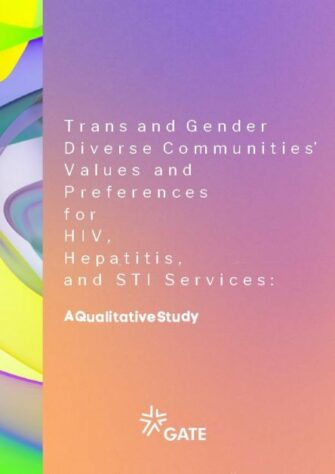Trans and gender diverse (TGD) people are considered a key population specifically vulnerable to HIV that bears a disproportionate burden of global HIV infections. TGD people are 13 times more likely to acquire HIV compared to the general population. Specifically, trans feminine people are strongly affected by this epidemic. Trans masculine people are, to date, under-researched, but studies have shown a 3% – 38% prevalence in this population. To date, there is no data available about HIV prevalence in trans non-binary people. Gathering the values and preferences of TGD people is a key step towards tackling this lack of data.
Inadequate inclusion in data collection makes it difficult to understand the lived realities of TGD people in general. Across different geographical and cultural regions, there is a wide variety of lived realities and experiences within this community. The differences in country legislations regarding legal gender recognition and, in some cases, criminalization of TGD individuals, may impact access to HIV/STI prevention, services, treatment, and care. The individual experiences across different country settings and the diversity of TGD people’s self-identification and bodily diversity present this community with unique needs and vulnerabilities regarding HIV, hepatitis and other STIs.
GATE conducted a qualitative study among global TGD community members to shed light on these needs and vulnerabilities and to understand the values and preferences regarding HIV, hepatitis, and STI services. This qualitative study was done in close collaboration with the World Health Organization (WHO) and with other key population networks, including the International Network of People Who Use Drugs (INPUD), MPact Action for Gay Men’s Health and Rights (MPact), and the Global Network of Sex Work Projects (NSWP). The outcomes of these studies informed the 2022 updated WHO Consolidated guidelines on HIV, viral hepatitis and STI prevention, diagnosis, treatment and care for key populations.
Recommendations
- Fight societal stigma and discrimination
- Improve access to legal gender recognition and gender-affirming care
- Offer education and training to healthcare providers, researchers, and policymakers about trans-specific needs and vulnerabilities
- Decrease the barriers to education and information about HIV, STIs, and viral hepatitis for TGD people
- Conduct more research and collect data about TGD experiences, needs, and vulnerabilities in order to produce adequate and scientifically sound prevention, care, and treatment materials to inform TGD communities
- Increase the inclusion of TGD people in research and data collection (not only as investigated populations but also as professionals in research design, implementation, data collection, and data dissemination)
- Increase access to more funding for peer-lead services, initiatives and interventions
- Strengthen capacity building and professionalization options for TGD community members with regard to HIV/STI prevention and care
- Highlight the need for targeted prevention campaigns interventions must consider the diversity of TGD identities (i.e., including transfeminine, transmasculine, AND non-binary trans identities) and their diverse bodies
- Increase the inclusion of TGD people in all (decision-making) boards, panels, groups, and advisory committees, taking into consideration the diversity of our community (i.e., including transfeminine, transmasculine, AND non-binary trans identities) that work on the risks and vulnerabilities of key populations






